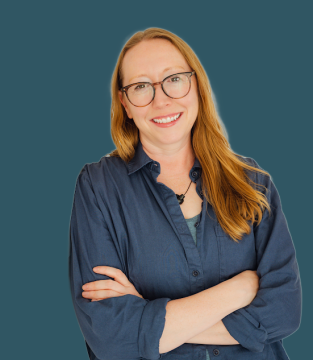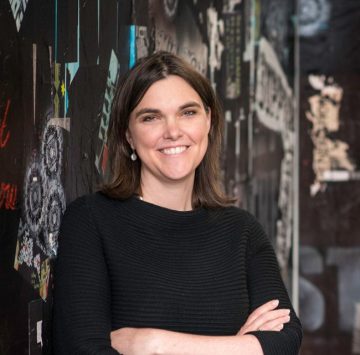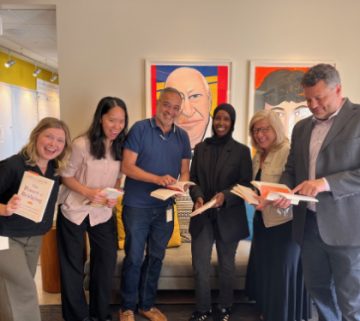Planning Ahead to Ensure User Adoption of New Technology
DATE
August 8, 2017
Contributors: Kelly Kleppe
The Bush Foundation launched a new Constituent Relationship Management (CRM) platform as well as an interconnected grantmaking system on January 1, 2016 after 18 months of planning, designing and testing with a dedicated technology consulting firm. We wanted to leverage new technology solutions that could help us be more effective at grantmaking, and therefore serve the region better. One thing we really cared about was making sure our staff was prepared to use the system and that the Foundation would be able to benefit from it, so we did a number of things to ensure user adoption. This learning paper summarizes what we took away from the process that might inform others looking to make sure staff are best equipped to embrace a new system.
Background
Our change in systems was driven by our new strategy to inspire, equip and connect people to think bigger and think differently about ideas to solve community problems. To do this work well, we needed to work differently. We started with a technology audit as an important tool to help us determine if our existing systems could continue to meet our needs. We received a very clear recommendation to adopt a CRM and to integrate it with our grants management system. We decided to implement one product (Salesforce) that with additional apps could do both.
Approach
This was a massive project for us! These systems are essential to our everyday operations. For this reason, it was important to have everyone involved in designing the effort. We started with a user readiness conversation with each employee to ensure employee engagement. We then started on phase one of our implementation, which meant reviewing all of our current data and cleaning it up for eventual conversion, plus mapping all of our fields. We put together a cross functional team that provided input and feedback on critical questions as they came up. In phase two of the project, this team was also important as we moved into designing the system to do things we had never done before with a true CRM. In our final implementation, this team helped ensure that information and training was shared, and helped make plans for timing and roll out. As you may have gleaned, the Bush Foundation is a collaborative workplace. We also strive to incorporate our values in everything we do. In this project, that meant making sure that everybody’s opinions were heard, and that we were doing more good every year. This intense interaction takes time, which is one of the reasons why it took 18 months to complete the project.
What Worked Well
FINDING THE RIGHT CONSULTANT
After engaging another independent, external consultant to do a technology audit and help us prioritize our technology projects, we started working with a local Salesforce consulting firm, Redpath Consulting, to help us implement our CRM, grantmaking and other related applications. Having a local consultant helped with user adoption because they were able to meet our staff face to face and ask them how they would use a new system. Our staff became familiar with them, and felt comfortable with their advice and counsel. Redpath also shared some of our most important values – in this case Everybody Matters. They helped us think through training and change management techniques that would help us be successful with staff at all user levels. For such an inclusive process with many touchpoints, working with a local consultant was extremely important.
INVOLVING STAFF FROM THE START
We made sure that all staff were involved in the project from the start. We did pre-planning, and asked all employees in one-on-one conversations and individual team meetings what they needed from a new system. This was a way for them to see their input in the final product and make sure it met everyone’s needs. We made sure to have a variety of perspectives on the planning team, which helped to build ownership. For us, this meant a large team that spanned all departments at the Foundation. They were an important information and advice-seeking conduit back to their teams. We also had internal champions in senior management who made sure that staff knew this project was important, and it was also a Board level strategic priority, so we had that important audience monitoring our progress as well. Being so inclusive surely slowed down the process, but we knew it would be beneficial in the long term.
COMMUNICATION AND TRAINING
We communicated about the project a lot! Our advice is to communicate more than you think is necessary. We provided a monthly written communication about the project and took every opportunity to share what was happening in all-staff meetings and through our internal social media platform.
We also found success in showing our staff the product before it went live to acclimate them to what it would look like. For us, this meant starting with the easy stuff – how to log in, how to navigate, how to search. We created handouts with screen prints and showed it on a “big screen” in a conference room. We created a testing environment with real data and gave people logins so that they could experience what it would really look and feel like with familiar data.
We held a variety of optional and mandatory training sessions before and after implementation. We found the most successful sessions were hands-on where staff brought their laptops. We videotaped sessions for people who couldn’t attend in person and made short videos available from Salesforce and YouTube on specific topics like searching and reports. We prepared a lot of documentation before we went live, and shared it as takeaways from training sessions. We also gave homework assignments or quizzes after our training sessions to drive home the point. One of the most successful training series—from a feedback and turnout perspective—was four optional sessions spread out over the four months before launch. We covered topics from how to log in, navigate and search, to how to identify relationships, to how to run reports. We also provided at least three additional sessions on deeper topics that arose from those optional trainings. We completed two mandatory training sessions with staff, one before going live and one approximately a month after. These sessions were customized to each team and what they would need to do specifically in our system to accomplish their jobs.
We continue to create helpful materials for our staff to give them easy access to data. For example, we have created many reports and pre-populated page views (Figure 1) so that commonly searched information is available at the click of a button. We have created visually appealing dashboards with charts and graphs (Figure 2), and fields that count up data (Figure 3) so that users can see data visually and without running any reports. We have added “help bubbles” (Figure 4) on individual fields to assist staff in understanding what they are used for, and shared common resource links in a side bar on every page (Figure 5). We’ve also added some additional apps and extenders that help people make better use of the system – for us this includes connectors to email, survey and event products. Mobile access via phone and tablet is also super important for our staff, and helps drive user adoption.
GAMIFYING THE SYSTEM
Even adults like prizes and contests! We found that giving people small incentives for attending training, doing challenges or logging in every day was a win. Office window clings (Figure 6) announcing that they had completed training were especially popular, and we made good use of coffee-shop gift cards, too. These small incentives were an inexpensive way to build excitement about the upcoming system. We also held a naming contest for the system, launching it with fanfare at our annual all-staff retreat, which helped people with buy-in as well. Ultimately, we named the system BRAD (Bush’s Really Awesome Database). We continue to have fun with the name, adding a middle and last name (Bush, of course) when we are feeling some frustration or confusion with the product. A little fun and levity in a busy office with a major technology project helped (and helps) us blow off some steam, and ensures a culture of shared ownership.
GOING DARK (AND LIGHT AGAIN)
To be prepared on day one, we completed grantmaking work for the year in November versus December so that we could use the final month of the year to transfer historical data and perform data verification in the new system. This meant that staff couldn’t use the old system for an entire month, and they couldn’t use the new system, either. We called this our “Dark Period.” When we first considered this, it seemed impossible that we could stop using our grants system for a whole month. Yet, with careful planning to ensure that all grants and payments were made before we went dark, this worked extremely well for us and enabled a complete and immediate transition. In fact, we liked it so much that we’ve made finishing our grantmaking by November an ongoing practice!
When we went light again on January 1st, we took away all access to our old system and made our staff rely entirely on the new system. It helped that we converted every bit of our historical data. But, we also didn’t leave people without support. We had our operations and technology staff and our dedicated technology consultants available to assist staff during work hours for the first full week of the roll-out. We continue to do lots of training one year later, and don’t see that stopping. One year into the work, staff want more information on how to find and report on data in the system, and on how to use the system for relationship management. Our grants administration and technology staff visit team meetings and provide just-in-time training, written resources and special sessions on specific topics. A few Foundation staff members have taken the lead in training their own teams and keeping the product front and center. New staff attend two orientation sessions to acclimate them to the system. We share instructional documents every time we ask someone to complete a process in the system, and we provide ongoing communication about any changes that are implemented.
What Didn’t Work Well
Because we were eager to please our colleagues, and because we couldn’t anticipate exactly how things would work in practice, we built things based on wishes and incomplete information, and installed apps that sounded good but that we haven’t used. We have had to undo some of the process automation we built, and are having to prod our staff to use some of the apps that have been installed. It takes constant diligence to ensure that the tools are the right ones, that people will use them and that people are trained appropriately. If we were to do it again, we would hold off on implementing some of these “wishes” and automations until we were using the system for real work and had a better idea of what we really needed.
Although many users voice satisfaction with our powerful new system, we are currently only harnessing part of its potential. We need to build usership and comfort and start expanding into broader CRM usage. It has taken more time than we anticipated to roll out some of the important CRM tracking features, such as logging interactions with prospective applicants or tagging contacts related to their interest areas. Reinforcing user adoption on new processes and functionality, even at a slower pace, is paramount to our success.
Foundation staff feel ownership, and that actually has complications! Because we are growing programs into their next iteration, and because people like the system and want to make it better, we are constantly receiving new ideas on how to improve our use of the product. We’ve finally figured out why people talk about the importance of creating a roadmap!
What’s Next
MORE TRAINING AND A ROADMAP
We have found that training and support is never done when using a product that is constantly upgraded, and with new apps that can be installed for just about any purpose. We have passion around creating and embedding training videos into the system to help those who learn with a more visual approach. We will be implementing a roadmap to guide any changes or enhancements that need to be made to the system, with an eye toward helping us be strategic about the projects we undertake. We have just begun implementation of a process to have staff submit their ideas for enhancements or major projects so that we can be fairer and more thoughtful about what gets implemented and on what timeframe. We think all of this will help balance the workload for those tasked with doing system enhancements, and make it clearer for everyone else.
Summary
We receive a lot of inquiries from other organizations thinking about implementing a CRM and integrated grantmaking platform. We strive to be open and honest with them about what we have learned and where some of our challenges have been. We especially like talking about user adoption and the importance of training and communication. We look forward to continuing those conversations, and invite you to contact us with any questions you may have. We’d also love to hear your ideas, successes and challenges when it comes to user adoption! Please share them with us at staff@bushfoundation.org.
Continue reading
-

News
Welcome to new Bush staff members
We are celebrating some new Bush colleagues and hope you get to meet them soon!
-

Note from Jen
Protecting our freedom to give
Do you know how CPR came to be? What about the 911 system? Ever wonder who developed the Pap smear? Or why school buses are all the same color? All these were the results of work funded by some foundation.
-

News
Introducing the Bush book club
Join us as we learn how to build a world where we all belong. And stay tuned as we get ready to welcome john a. powell to Minnesota for a special Bush book club event!